In this article, warnings and prognosis as they relate to endodontics will be explored in more detail and will hopefully provide a guide in the decision making process. Additionally, if the clinician can thoroughly assess a case prior to commencement, a treatment plan can be formulated which may indeed mean no treatment at all! As Professor Messer wrote in 1999:
‘Clinical judgement tends to be subjective. One dentist may attempt to treat a tooth which another would regard as hopeless…the challenge for us as dentists is to become more objective in our decision-making by developing a systematic approach to the assessment of difficulty of endodontic cases’.[1]
The ‘objectivity’ Professor Messer mentions is critical and the reason why I have previously stated I have concerns with practitioners citing success rates which may not at all be applicable to how they practice, their experience or applicable to the case at hand and as it presents.
The American Academy of Endodontists[2] has available on their web site (www.aae.org) guidelines for assessing the difficulty of endodontic cases. The form is divided into three categories which, when formulating a treatment plan, could be applied to any discipline of dentistry and factors which should be carefully considered prior to commencement of treatment. The Academy recommends that a rating be applied to each of these factors and that a ‘risk level’ be assigned as follows:
1 = Average Risk – ‘average or routine complexity’.
2 = High Risk – ‘complicated…with one or more treatment/patient impediment factors’.
3 = Extreme Risk – ‘exceptionally complicated…achieving a predictable treatment outcome will be challenging for even the most highly skilled practitioner’.
The AAE state that ‘if any one or more factor is rated high (2) or extreme (3) risk, then referral to an endodontist may be appropriate.
So, in endodontics specifically, it should not be difficult to assign such risks. With time and experience, the assigning of them should become almost ‘second nature’. If a clinician does not feel comfortable taking on a difficult and complex endodontic case or if the tooth has a hopeless prognosis, no amount of pressure from the patient to not be referred (or the removal of the tooth) could be used as a defence to litigation.
The three categories to be considered are as follows:
- Patient Considerations
- Objective Clinical Findings
- Additional Conditions
Rather than explore every aspect of each of these considerations, pertinent points will be highlighted as potential ‘barriers’ to treatment. Assigning the risk objectively may not always be easy but will fortunately assist in avoiding litigation and complaints in the future.
Patient considerations
‘limited ability to open mouth’ – what impact on success does limited opening have on treating tooth 11 as opposed to tooth 17? Will the same result be achieved for both teeth?
‘gagger’ – will the clinician be able to take an adequate working length film for tooth 36? Should sedation be considered to assist in achieving the best possible outcome?
Objective clinical findings
‘pulpal space’ – calcification, chamber, orifice, canal, number of canals
‘root morphology’ – curvature, length
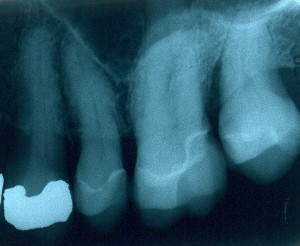
Our concerns here should be obvious – the marked curvature as well as the receded pulp chamber, with risk factors 2 and 3 dominant. These issues need to be discussed prior to commencement.
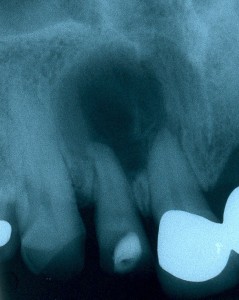
On the other hand, in the case illustrated above, our concerns here are not with the endodontic treatment – simple and straightforward. However, when a large well-circumscribed periapical radiolucency such as this one presents, I am immediately wary of the possibility of surgery and the consultation appointment is spent discussing both procedures.
‘apical morphology’ – open
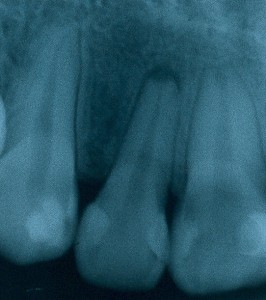
Although a seemingly innocuous case, the apical inflammatory resorption needs to be considered and the potential impact on treatment outcome. Is there a possible overfill ‘waiting’ here? If so, does a straightforward RCT then become a surgical case? Should MTA be used and if so, do you have the necessary skill and expertise to use and manipulate the material?
Additional conditions
‘restorability’ – isolation, caries, crown lengthening
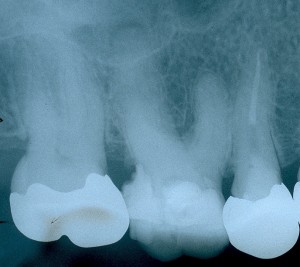
The depth of the restoration is a concern and our ability to maintain an adequate coronal seal. Will crown lengthening be indicated? There has also been a previous attempt at endodontic access and what appear to be calcified canals.
‘resorptions’ – internal, external, apical
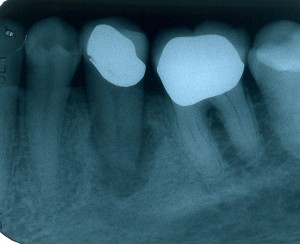
The resorptive process here is quite advanced…what impact does this have on treatment and outcome? The approach here should be one of caution – I would be advising the patient that the tooth is compromised and would explain the process of resorption and what the aim of RCT would be.
‘endo-perio’ – mobility, pocketing
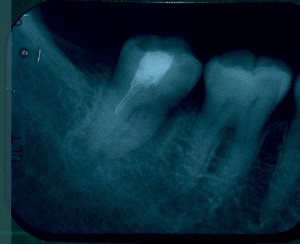
The mesial bone loss and deep discrete pocketing immediately should set off ‘alarm bells’ in this case and the patient must be informed from the outset of the dubious prognosis. There is nothing wrong here in telling the patient that you are suspicious of a possible fracture which could have a devastating long term impact on prognosis.
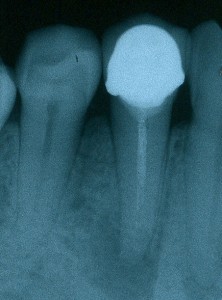

‘previous RCT’ – Rate 2 or 3 only
‘perforations’ – Rate 3 only
The last two are compelling and reflect the difficulties even endodontists encounter with re-treatments and perforations. So, prior to embarking on these types of cases, the clinician must stress to the patient the complexity and difficulty of the case, referral must be offered each time and if treatment is to proceed, the patient’s (and your) expectation of success should be realistic.
During the course of treatment, prognosis can change and potentially be out of our control. Additionally, in endodontics, flare ups can occur and I have found it useful to advise patients after every appointment that they may experience pain and/or swelling and briefly explain why. In this way they are forewarned and almost expect discomfort.
The above examples are by no means exhaustive but hopefully provide an insight into what the clinician needs to consider prior to commencement of endodontic treatment. I have attempted to illustrate different issues which I consider important prior to commencing treatment and share with you what I share with patients. Just as treatment is dynamic so should our ability to objectively assess each case on its own merits. Again, as Professor Messer stated:
“…it is a serious overstatement to tell patients that endodontic treatment is successful in 90-95% of cases…’ If one is to use statistics such as these, then a number of conditions need to be satisfied: ‘rigorous bacterial control, including the use of rubber dam and medicaments; no procedural difficulties…; a durable coronal seal…; a final restoration that provides adequate protection against crown-root fracture; good periodontal condition. The patient (and the dentist) may seriously consider alternative approaches if the prospect of success is diminished…or if multiple problems are present”.
It has been the intent of these two articles to provide an alternative perspective at endodontic ‘treatment planning’. It is important that when we use a term such as ‘informed consent’ we do not confuse it with a signed sheet of paper. Informing the patient with discussion, explanation, diagrams, visual aids and of course information pamphlets, all go a long way to not only providing protection from litigation but also, in all likelihood, prevention of such action.
If at any stage you have a question or wish to discuss a particular case, please feel free to contact David Sweeney, Peter Crozier, Roger Dennett, Colette Dailey or me at the DDAS – we’re happy to assist with any situation which may arise.
Dr Stephen Harlamb BDS, MDSc
Peer Advisor, ADA NSW
[1] Clinical Judgement and Decision Making in Endodontics, Professor Harold Messer, Australian Endodontic Journal, Vol 25 (3) 1999, p124-132
[2] http://www.aae.org/dentalpro/CaseAssmtReferral.htm